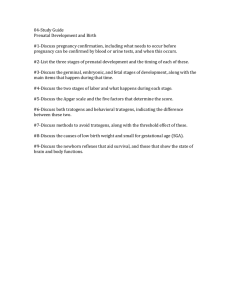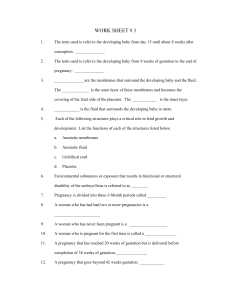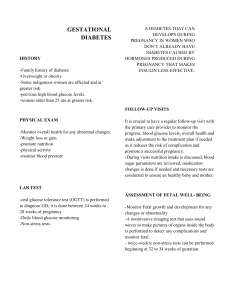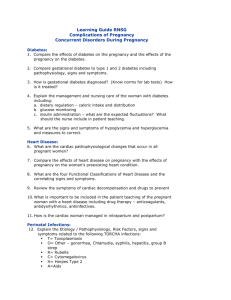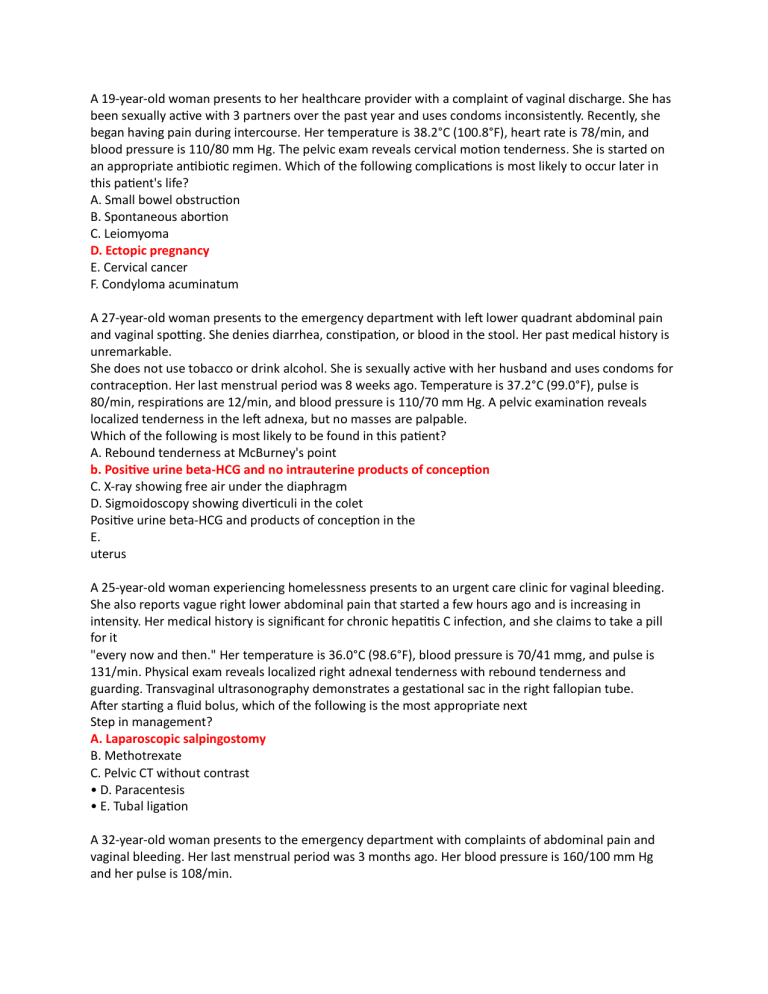
A 19-year-old woman presents to her healthcare provider with a complaint of vaginal discharge. She has been sexually active with 3 partners over the past year and uses condoms inconsistently. Recently, she began having pain during intercourse. Her temperature is 38.2°C (100.8°F), heart rate is 78/min, and blood pressure is 110/80 mm Hg. The pelvic exam reveals cervical motion tenderness. She is started on an appropriate antibiotic regimen. Which of the following complications is most likely to occur later in this patient's life? A. Small bowel obstruction B. Spontaneous abortion C. Leiomyoma D. Ectopic pregnancy E. Cervical cancer F. Condyloma acuminatum A 27-year-old woman presents to the emergency department with left lower quadrant abdominal pain and vaginal spotting. She denies diarrhea, constipation, or blood in the stool. Her past medical history is unremarkable. She does not use tobacco or drink alcohol. She is sexually active with her husband and uses condoms for contraception. Her last menstrual period was 8 weeks ago. Temperature is 37.2°C (99.0°F), pulse is 80/min, respirations are 12/min, and blood pressure is 110/70 mm Hg. A pelvic examination reveals localized tenderness in the left adnexa, but no masses are palpable. Which of the following is most likely to be found in this patient? A. Rebound tenderness at McBurney's point b. Positive urine beta-HCG and no intrauterine products of conception C. X-ray showing free air under the diaphragm D. Sigmoidoscopy showing diverticuli in the colet Positive urine beta-HCG and products of conception in the E. uterus A 25-year-old woman experiencing homelessness presents to an urgent care clinic for vaginal bleeding. She also reports vague right lower abdominal pain that started a few hours ago and is increasing in intensity. Her medical history is significant for chronic hepatitis C infection, and she claims to take a pill for it "every now and then." Her temperature is 36.0°C (98.6°F), blood pressure is 70/41 mmg, and pulse is 131/min. Physical exam reveals localized right adnexal tenderness with rebound tenderness and guarding. Transvaginal ultrasonography demonstrates a gestational sac in the right fallopian tube. After starting a fluid bolus, which of the following is the most appropriate next Step in management? A. Laparoscopic salpingostomy B. Methotrexate C. Pelvic CT without contrast • D. Paracentesis • E. Tubal ligation A 32-year-old woman presents to the emergency department with complaints of abdominal pain and vaginal bleeding. Her last menstrual period was 3 months ago. Her blood pressure is 160/100 mm Hg and her pulse is 108/min. On exam, her fundal height is 23 cm. An ultrasound reveals a grape-like mass in the uterus, and no fetal parts are seen. What will be the most likely genotype of the substance aspirated by dilation and evacuation? 0 A. 69 XXY B. 45 XO C. 23 XX D. 47 XYY E. 46 XX Research is being conducted on a developing embryo approximately 10 days after fertilization. There is the presence of a cytotrophoblast and syncytiotrophoblast. Within the embryo, columnar and cuboidal cells are separated by a membrane. Which of the following cell layers in this embryo will soon line the embryonic cavity to form the primitive yolk sac? A. Epiblast B. Inner cell mass C. Hypoblast D. Endoderm E. Syncytiotrophoblast A 24-year-old G1P0 woman presents to her healthcare provider for regular prenatal care at 31 weeks gestation. She is feeling well and the pregnancy has been uncomplicated. Her pre-gestational history is significant for obesity (BMI = 30.5 kg/m?). She has gained a total of 10 kg (22.4 |b) during pregnancy and 2 kg (4.48 lb) since her last visit 4 weeks ago. Vital signs include: blood pressure 145/90 mm Hg, heart rate 87/min, respiratory rate 14/min, and temperature 36.7°C (98°F). The fetal heart rate is 153/min. Physical exam reveals a 2/6 systolic murmur best heard at the apex. There is no peripheral edema. A 24-hour urine sample is negative for protein. Which of the following is the most appropriate next step in management? A. Admission to the hospital for observation B. Treatment in the outpatient setting with labetalol C. Observation in the outpatient setting D. Treatment in the inpatient setting with methyldopa E. Treatment in the outpatient setting with nifedipine A 26-year-old woman, gravida 1, para 0, presents to her physician at 35 weeks' gestation with new-onset lower leg edema. Her pregnancy has been uneventful, and she has been adherent to the recommended prenatal care. She reports a four-pack-year smoking history before her pregnancy. She also has a history of oral contraceptive use. Her family history is remarkable for hypertension in her mother. Before pregnancy, her BMI was 19.8 kg/m?. Her blood pressure is 145/90 mm Hg, pulse is 91/min, respirations are 15/min, and temperature is 36.6°C (97.9°F). The blood pressure is unchanged 15 minutes and 4 hours after the initial measurement. The fetal heart rate is 144/min. Physical exam reveals 2+ pitting lower leg edema. There are no focal neurologic deficits. A urine dipstick test shows 2+ proteinuria. Which of the following is the strongest risk factor for her condition? A. Smoking before pregnancy B. Oral contraceptive use C. First pregnancy D. BMI = 20 kg/m prior to pregnancy E. Family history of hypertension A 25-year-old woman, gravida 1, para 0, presents to her physician for a routine prenatal visit at 34 weeks' gestation. She is feeling well but notes that the new shoes she bought 2 weeks ago do not fit anymore. Her pregnancy has been uneventful, and she has been adherent to the recommended prenatal care. Her medical history is unremarkable. She has gained 15 pounds since the last visit 3 weeks ago. Her blood pressure is 148/90 mm Hg, pulse is 88/min, respirations are 16/min, and temperature is 36.6°C (97.9°F). The blood pressure on repeat assessment 4 hours later is 151/90 mm Hg. The fetal heart rate is 151/min. Physical exam reveals 2+ pitting edema of the lower extremities. Which of the following diagnostic tests is most appropriate at this time? A Bilirubin level B. Coagulation studies C. Hematocrit level D Leukocyte count with differential E. 24-hour urine protein A 25-year-old woman, gravida 1, para 0, is admitted to the hospital at 35 weeks' gestation with lower leg edema. She denies any other symptoms. The pregnancy has otherwise been unremarkable, and she is adherent to the recommended prenatal care. Her blood pressure is 155/90 mm Hg, pulse rate is 84/min, respiratory rate is 16/min, and temperature is 36.6°C (97.9°F). The fetal heart rate is 142/min. Physical exam reveals 2+ pitting edema. A 24-hour urine assessment shows proteinuria (1.2 g). Ultrasound demonstrates a normally developing fetus without structural abnormalities. The placental margin is located 6 cm away from the internal os. Which of the following is the most appropriate next step in management? A.Induction of vaginal delivery at 37 weeks' gestation if it does not begin spontaneously before then B. Cesarean delivery after a course of corticosteroid treatment c. induction of vaginal delivery after a course of corticosteroid treatment D. Cesarean delivery at 37 weeks' gestation or urgently if spontaneous labor occurs before then E Wait for spontaneous vaginal delivery at any time A 22-year-old woman, gravida 1, para 0, at 35 weeks' gestation, is admitted to the obstetrics ward with leg swelling. She denies any other symptoms. Her pregnancy has been uneventful, and she is adherent to the recommended prenatal care. Her blood pressure is 168/95 mm Hg, pulse is 86/min, respirations are 16/min, and temperature is 36.7°C (98°F). The fetal heart rate is 141/min. Physical exam reveals 2+ pitting edema of the lower extremities. A dipstick test shows 1+ proteinuria. On reassessment 15 minutes later, her blood pressure is 141/88 mm Hg, and the fetal heart rate is 147/min. A decision was made to observe the patient and continue the workup without initiating antihypertensive therapy. Which of the following would define a severe form of this condition? • A. 24-hour urinary protein of 5 g/L • B. Severe new-onset headache C. Hematocrit of 48% • D. Platelet count 133,000/uL • E. Serum creatinine 0.98 mg/dL A 23-year-old G1P0 woman with no co-morbidities presents at 34 weeks' gestation with edema and a moderate headache. Her blood pressure at her previous examination was 125/82, and is now 147/90 mm Hg, her heart rate 82/min, her respiratory rate 16/min, and her temperature 36.6°C (97.9°F). A physical exam reveals 2+ pitting edema in the lower extremities. A urine dipstick test shows 2+ proteinuria. Laboratory studies show the following. Which of the lab measurements listed defines this as a severe form of this patient's condition? Hemoglobin B. Leukocyte count • C. Total bilirubin • D Liver transaminases •E Creatinine A 25-year-old woman, gravida 1, para 0, is admitted to the hospital at 36 weeks' gestation after a generalized tonic-clonic seizure. She is conscious but lethargic and complains of a headache that started 2 hours before the seizure She denieh alcohol intake or drug use. She has no history of a seizure disorder, and the pregnancy has been otherwise unremarkable. Her last prenatal visit was 2 weeks ago, and she has been adherent to recommended care. She has gained 2 kg (4.4 |b) since her last visit. Her blood pressure is 160/90 mm Hg, pulse is 79/min, respiratory rate is 14/min, and her temperature is 37.0°C (98.6°F). Physical exam reveals bilateral lower leg edema, diffuse hyperreflexia, and ankle clonus. Which of the following laboratory findings would most likely be found in this patient? • A Elevated transaminases • B. Leukocytosis • C. Hematuria • D. Hyponatremia • E. Proteinuria A 25-year-old woman, gravida 1, para 0, is admitted to the hospital at 36 weeks' gestation with a severe frontal headache. Her blood pressure is 170/90 mm Hg, pulse is 85/min, respirations are 15/min, and temperature is 36.9°C (98.4°F). The fetal heart rate is 159/min. There is 1+pitting edema of both lower extremities on physical exam. A dipstick urine assessment shows 2+ proteinuria. While being evaluated, the patient has a generalized tonic-clonic seizure. What pharmacologic agent is the most appropriate for preventing recurrent seizures? Auto Tr • A. Valproic acid B. Diazepam • C. Phenytoin • D. Magnesium sulfate • E. Lamotrigine A 24-year-old woman, gravida 1, para 0, is admitted to the hospital after a tonic-clonic seizure at 37 weeks' gestation. She complains of a severe headache, double vision, and dizziness. Her blood pressure is 165/90 mm Hg, pulse is 91/min, respiratory rate is 10/min, and temperature is 37.0°C (98.6°F). The fetal heart rate is 118/min. A urine dipstick test shows 3+ proteinuria. The patient is lethargic and has 2+ pitting edema in the lower extremities. She has no neck stiffness or meningeal signs. A neurologic exam is significant for left eye deviation toward the nose, impaired adduction on lateral gaze, intact convergence with nystagmus in the right eye, and right hemiplegia. Which of the following would most likely be seen on a head CT scan? A. Regions of hyperdensity within the cerebellar hemispheres • B. Hyperattenuating material in the subarachnoid space • C. Regions of hyperdensity in the left pons • D. Cord-like hyperattenuation in the superior sagittal sinus Subcortical hypodense region with surrounding irregular E. hyperdense margins A 33-year-old woman, gravida 2, para 1, at 35 weeks' gestation, is admitted to the hospital with fever and active labor. She reports a 2-day history of fluid leakage from the vagina without pain or bleeding. Her pregnancy has otherwise been uncomplicated. She has attended many prenatal appointments and followed the physician's advice regarding routine screenings, laboratory testing, diet, and exercise. Her previous pregnancy was complicated by a preterm delivery at 34 weeks' gestation. The patient reports a 10-pack-year history of smoking before pregnancy and smoked four cigarettes daily during pregnancy. At the hospital, her temperature is 39.6°C (103.3°F), blood pressure is 108/60 mm Hg, and pulse is 125/min. Her BMI is 18.2 kg/m2 Uterine palpation reveals tenderness. Cervical examination indicates 100% effacement and 10 cm dilation. Her lungs are clear to auscultation. The baseline fetal heart rate has been 180/min for the last 15 minutes. Which of the following is the most appropriate next step in management? A. Amnioinfusion • B. Ampicillin and gentamicin • C. Cesarean delivery • D. Intravenous betamethasone • E. Ritodrine hydrochloride A 45-year-old primigravida is brought to the hospital in labor at 39 weeks' gestation. After 4 hours, she gives birth to a healthy-appearing baby boy with APGAR scores of 7 at 1 minute and 9 at 5 minutes. She had limited prenatal screening but did have an ultrasound at 35 weeks that showed polyhydramnios. The next day, the neonate vomits greenish-yellow fluid after breastfeeding. This occurs 2 more times that day after feeding and several times between feedings. The next day, the neonate appears weak with difficulty latching to the breast and is dehydrated. The provider on duty is concerned and orders blood work, IV fluids, and the abdominal X-ray shown below. Which of the following disorders is most associated with this newborn's symptoms? A. Trisomy 18 B. Trisomy 13 C. Trisomy 21 D. 47 XXY E. 45 XO A 25-year-old woman, gravida 2, para 1, comes to the provider for her initial prenatal visit at 18 weeks gestation. She recently immigrated from Thailand. Her history is significant for anemia since childhood that has not required any treatment. Her mother and husband also have anemia. She has no history of serious illness and takes no medications. Her vital signs are within normal limits. Fundal height measures at 22 weeks. Ultrasound shows polyhydramnios with pleural effusion and ascites in the fetus. What is the most likely clinical course for this fetus? A. Asymptomatic anemia B. Carrier state C. Fetal death in utero D. Neonatal death E. Normal development with regular blood transfusion A 34-year-old man presents to a clinic with complaints of abdominal discomfort and blood in the urine for 2 days. The sensation of discomfort has been present for 5 years, but the blood in his urine is new. He has had hypertension for the past 2 years, for which he has been prescribed medication. He has no history of weight loss, skin rashes, joint pain, vomiting, change in bowel habits, or smoking. On physical examination, there are ballotable flank masses bilaterally. His bowel sounds are normal. Selected laboratory tests show the following Serum BUN Serum creatinine Urine protein Urine RBC 50 mg/dL 1.4 mg/dL Negative Numerous Ultrasonography of the abdomen reveals enlarged kidneys and multiple anechoic cysts with well-defined walls. A CT scan confirmed the presence of multiple cysts in the kidneys. What is the most likely diagnosis? A. Autosomal dominant polycystic kidney disease (ADPKD) B. Autosomal recessive polycystic kidney disease (ARPKD) • C. Medullary cystic disease • D. Simple renal cysts • E. Acquired cystic kidney disease A 40-year-old woman with high blood pressure and diabetes presents to the outpatient clinic and states that she is trying to get pregnant via in vitro fertilization. Her current medications include lisinopril, metformin, and sitagliptin. Her blood pressure is 136/92 mm Hg, and her heart rate is 76/min. Her physical examination is unremarkable. What should be done regarding her hypertension medication? A. Continue her current regimen. • B. Discontinue lisinopril and initiate labetalol. c. Continue her current regimen and add a beta blocker for D. Discontinue lisinopril and initiate candesartan. E. Discontinue lisinopril and initiate aliskiren. A newborn girl is rushed to the neonatal ICU after delivery due to unstable vital signs. The pregnancy was complicated due to oligohydramnios and pulmonary hypoplasia. She was born at 38 weeks gestation via spontaneous vaginal delivery after rupture of membranes. APGAR scores were 6 and 8 at one and five minutes, respectively. The temperature is 37.0°C (98.6°F), blood pressure is 60/40 mm Hg, respirations are 45/min, and pulse is 140/min. Physical examination reveals irregularly contoured bilateral abdominal masses. Abdominal ultrasound reveals markedly enlarged echogenic kidneys (5 cm in the vertical dimension) with multiple cysts in the cortex and medulla. This patient is most at risk of which of the following complications? A. Subarachnoid hemorrhage B. Emphysema • C. Portal hypertension • D. Self-mutilation What is gestational diabetes? Impaired glucose tolerance before pregnancy. Impaired glucose tolerance at the onset of, or first recognized during pregnancy. Impaired glucose tolerance 6 months post-pregnancy Impaired glucose tolerance after a baby is born. According to White's Classification, what is considered class A2? Fasting plasma glucose levels less than 105 and less than 120 postprandial. Fasting plasma glucose levels greater than 105 and less than 120 postprandial. Fasting plasma glucose levels less than 105 and greater than 120 postprandial. Fasting plasma glucose levels greater than 105 and greater than 120 postprandial. What best describes the insulin requirements during pregnancy? Insulin requirements vary from client to client Insulin requirements increase Insulin requirements decrease Insulin requirements remain the same The placenta's hormones have what effect on insulin? Insulin resistance No change to insulin levels Normal glucose levels in the blood Low glucose levels in the blood A client with pre-existing diabetes before pregnancy can expect what consequence during their pregnancy? Select all that apply. Accelerated vascular changes Impaired insulin action Higher risk for ketoacidosis Altered carbohydrate metabolism Decreased carb metabolism What are the three hormones that the placenta produces? Select all that apply. Progesterone Human placental lactogen Testosterone Estrogen Cortisol What is the potential maternal complication in pregnant women with diabetes? Hunger Polyhydramnios Dysuria Oligohydramnios Risk factors for gestational diabetes include which of the following? Select all that apply. Client older than 38 Hypertension Hypotension Obesity Client older than 25 Maternal complications of diabetes include which of the following? Select all that apply. Weight gain Pre-eclampsia Weight loss Maternal hypoglycemia Hypotension Which of the following could be a potential Fetal complication with a diabetic mother? Select all that apply Prematurity Low weight Macrosomia Cardiomyopathy A client is has completed step 2 testing for gestational diabetes screening. The client's results are 130, 190, 150, 145. What can we conclude from the client's results? The client is not gestational diabetic. The client will be diagnosed with gestational diabetes. Another step 2 test will need to be completed. An oral glucose tolerance test will be completed. What is an ideal maternal blood sugar on a hemoglobin A1C test? Between 5% and 6% 7.5% Less than 8% Between 3% and 4% Signs of hypoglycemia include which of the following? Select all that apply. Weakness Fruity breath Polyuria Headache Nervousness Signs of hyperglycemia include which of the following? Select all that apply Polyphagia Polyuria Feeling weak Blurred vision Polydipsia What are the goals for treatment for a gestational diabetic in the antepartum stage? Select all that apply. Detect pregnancy complications Avoid hypertension Avoid ketosis Avoid FITT Prevent fetal macrosomia A client who is a gestational diabetic should have diet goals that include which of the following? Select all that apply. Avoid ketosis A minimum of 300g of carbohydrates a day Avoid extreme weight gain or loss A minimum of 175g of carbohydrates a day 5–7 meals per day To assess for fetal well being a client is instructed to count fetal movements. When does the healthcare provider advise the client who is diagnosed with gestational diabetes to start kicking counts? 25 weeks 32 weeks 38 weeks 20 weeks A gestational diabetic client treated with insulin during her pregnancy will be typically instructed to start biophysical profiles twice per week at what point in her pregnancy? 32–34 weeks 34–36 weeks 30–32 weeks 28–30 weeks A gestational diabetic client who has been managing her diagnosis with diet during her pregnancy will be typically instructed to start biophysical profiles twice per week at what point in her pregnancy? 38–40 weeks 32–34 weeks 34–36 weeks 30–32 weeks The F in the FITT principle stands for frequency related to fitness for a client diagnosed with gestational diabetes. How often does FITT recommend that a client exercise? At least three times a week of moderate exercise At least six times a week of low impact exercise At least once per week At least five times a week of high-intensity exercise A client was diagnosed with gestational diabetes during pregnancy, and the newborn's blood sugar is 19. A blood sugar of 19 is considered which of the following? A low blood sugar, but it can be managed An emergency A normal blood sugar A high blood sugar A client who has given birth and was diagnosed with gestational diabetes can typically leave the hospital in what timeframe? 1 week 24 hours 48 hours After 3 days A client who was diagnosed with gestational diabetes is six weeks postpartum. When they are tested for diabetes postpartum, how many grams of sugar is utilized for the screening? 50 100 75 25 Which of the following are considered risk factors for gestational diabetes? Select all that apply. Infertility History of pregnancy loss Age greater than 22 Age greater than 25 Family history Which of the following are considered maternal complications of gestational diabetes? Select all that apply. Hypotension High blood pressure Weight loss Hypoglycemia Weight gain Which of the following is the best diagnostic test for rupture of membranes? Nitrazine paper or swab changing color when placed in the vagina Ferning of suspected amniotic fluid seen under a microscope Maximum vertical pocket less than 2 cm on ultrasound Reported history of a large gush of fluid Pooling of amniotic fluid on speculum exam with Valsalva maneuver When should antibiotics be prescribed for rupture of membranes after 37 weeks of gestational age? If the client has an unknown group B streptococcus status If the client has a negative group B streptococcus rectovaginal screening swab If the client's membranes have been ruptured for over four hours before the onset of labor If the client has a group B streptococcus rectovaginal screening swab done before 35 weeks of gestational age If the client has a positive group B streptococcus culture in urine or screening rectovaginal swab What are the effects of steroids given for preterm premature rupture of membranes? Increases in fetal lung surfactant production and alveolar recruitment Increases in fetal risk for intraventricular hemorrhage Increases in fetal risk for necrotizing enterocolitis Fetal neuroprotection against cerebral palsy Increases in latency period to prevent delivery before 34 weeks When is labor considered preterm? Before 32 weeks Before 35 weeks Before 37 weeks Before 40 weeks How many babies are born prematurely in the United States? 1 in 5 1 in 20 1 in 10 1 in 15 What are the risk factors for preterm delivery? Select all that apply. Cocaine use Stress Singular gestation Periodontal disease Previous at-term birth What are indications that a client’s membranes have ruptured? Select all that apply. Negative fern test Vaginal bleeding Leakage of clear fluid from the cervical os Postive nitrazine test Negative beta HcG test The student nurse is caring for a pregnant client with premature ruptured membranes. Which student nurse action causes the clinical instructor to intervene? The student nurse provides emotional support to the client and walks them through the following steps. The student nurse administers a prophylactic antibiotic as prescribed by the provider. The student nurse explains the importance of fetal surveillance to the client. The student nurse tells the client that they will perform cervical checks at increased intervals. A premature infant is at risk for which conditions? Select all that apply. Hyperthermia Intraventricular hemorrhage Hyperglycemia Long-term disabilities Hyperbilirubinemia What is true about terbutaline? Select all that apply. It is contraindicated in clients with heart disease. It is an adrenergic agonist. It is given only by IV. Tachycardia is an expected effect. It is the drug of choice for clients with severe preeclampsia. What is true about nifedipine? Select all that apply. It should not be given to clients with hypotension. It aids in relaxing the uterus. It is a calcium channel blocker. It is given by IV. It is a CNS depressant. What can be given to the birthing client to prevent respiratory distress in the premature newborn? Select all that apply. Terbutaline Magnesium sulfate Betamethasone Nifedipine Dexamethasone What may a provider order to help prevent preterm labor or birth? Select all that apply. Oxytocin Progesterone Estrogen Nifedipine Cerclage A 27-year-old pregnant woman at 22 weeks gestation, G3P1, visits her physician for a prenatal visit. She feels well. Her current pregnancy has been uncomplicated. She has attended all her prenatal appointments and followed the physician's advice about screening for diseases, laboratory testing, diet, and exercise. The patient's previous pregnancies were complicated by preterm labor at 24 weeks gestation in one pregnancy and spontaneous abortion at 20 weeks in the other. She takes a multivitamin with folate every day. At the physician's office, her temperature is 37.2°C (99.0°F), and blood pressure is 100/61 mm Hg. Pelvic examination shows a uterus consistent in size with a 20-week gestation. Fetal heart sounds are normal. An ultrasound shows a short cervix, measured at 20 mm. Which of the following is the most appropriate next step in management? A. Bed rest Auto B. Cerclage C. Cervical pessary D. Intramuscular progesterone E. Intravenous betamethasone • F. Terbutaline G. Vaginal progesterone A 24-year-old woman, gravida 1, at 36 4/7 weeks gestation, is admitted to the hospital with regular contractions and pelvic pressure for the last 5 hours. Her pregnancy has been uncomplicated, and she has attended many prenatal appointments and followed the physician's advice about screening for diseases, laboratory testing, diet, and exercise. She tested negative for Group B Streptococcus at her most recent visit. She has had no history of fluid leakage or bleeding. At the hospital, her temperature is 37.2°C (99.0°F), blood pressure is 108/60 mm Hg, pulse is 88/min, and respiratory rate is 16/min. Cervical examination shows 60% effacement and 5 cm dilation with intact membranes. The electronic fetal monitor shows a contraction amplitude of 220 Montevideo units (MVUs) in 10 minutes (adequate contractions are defined as a total of 200 MVUs within 10 minutes). Which of the following is the most appropriate therapy at this time? • A. Dexamethasone • B. Magnesium sulfate • C. Oxytocin • D. Terbutaline • E. No pharmacotherapy at this time
